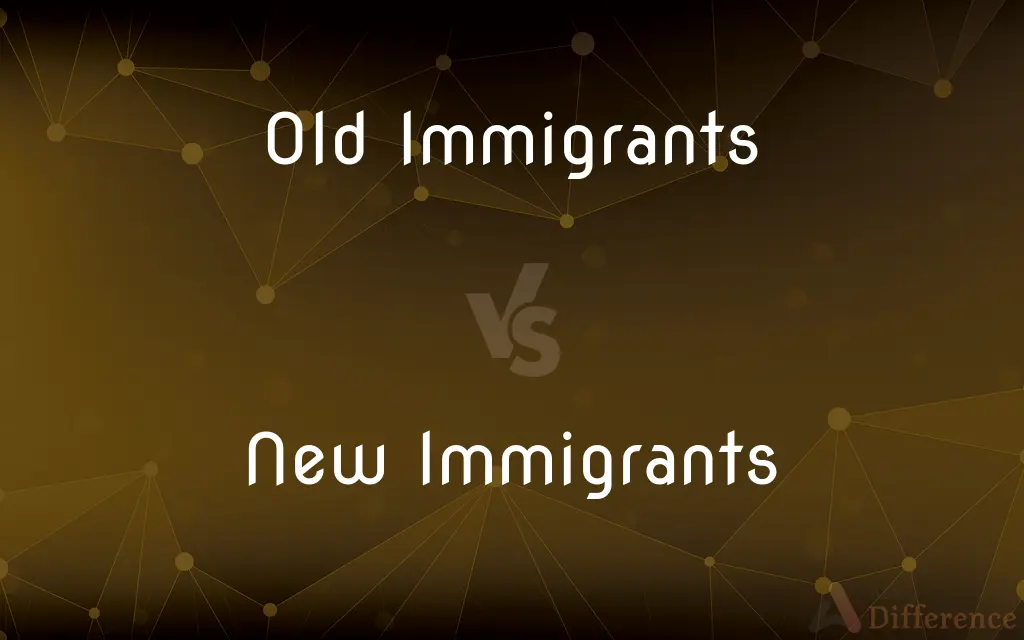Old Immigrants vs. New Immigrants — What's the Difference?
By Tayyaba Rehman & Maham Liaqat — Published on March 2, 2024
Old Immigrants hailed from Northern and Western Europe before the 1880s, integrating relatively smoothly into American society due to cultural similarities. New Immigrants came from Southern and Eastern Europe, Asia, and other regions after the 1880s.

Difference Between Old Immigrants and New Immigrants
Table of Contents
ADVERTISEMENT
Key Differences
The distinction between Old Immigrants and New Immigrants in American history is primarily based on the time of arrival and origin. Old Immigrants, arriving before the 1880s, primarily came from Northern and Western Europe, including countries like Germany, Ireland, and the United Kingdom. They were often Protestant, spoke English, or shared cultural characteristics with the existing American population, which facilitated their assimilation into American society.
New Immigrants, arriving from the 1880s to the early 20th century, originated from Southern and Eastern Europe, including Italy, Russia, and the Balkans, as well as Asia and other regions. These groups often practiced different religions, such as Catholicism, Judaism, or Eastern Orthodoxy, and brought diverse languages and customs. Their distinct cultural backgrounds posed challenges to assimilation, leading to increased xenophobia and nativism among the American populace.
The economic contributions of both groups were significant, with Old Immigrants often moving into farming in the Midwest or engaging in trade and skilled labor in urban areas. New Immigrants, meanwhile, were pivotal in the rapid industrialization of the United States, taking up low-wage labor in factories, mines, and railroads, often under harsh conditions.
Social integration patterns differed markedly between the two groups. Old Immigrants, with their closer cultural ties to the Anglo-Saxon majority, faced fewer barriers to social mobility and were more readily accepted. New Immigrants encountered ethnic and religious prejudice, leading to the formation of tight-knit ethnic communities and neighborhoods that preserved their languages and traditions.
Legislation also reflected these differences. The U.S. government implemented more restrictive immigration laws in the early 20th century, aimed primarily at limiting the influx of New Immigrants. These included literacy tests and quotas based on national origin, which were not a concern for Old Immigrants who had already established their presence in American society.
ADVERTISEMENT
Comparison Chart
Time Period
Before 1880s
1880s to early 20th century
Origin
Northern and Western Europe
Southern and Eastern Europe, Asia
Religions
Mainly Protestant
Catholic, Jewish, Eastern Orthodox
Language and Customs
Similar to Anglo-Saxon majority
Diverse, different from the majority
Assimilation
Easier due to cultural similarities
More challenging due to diversity
Economic Contributions
Farming, trade, skilled labor
Industrial labor, factories, railroads
Social Integration
Smoother, quicker acceptance
Formation of ethnic communities
Legislative Impact
Fewer restrictions
Targeted by restrictive laws
Compare with Definitions
Old Immigrants
Less impacted by restrictive immigration laws.
By the time strict laws were enacted, many Old Immigrants were already citizens.
New Immigrants
Encountered significant assimilation challenges.
New Immigrants faced discrimination and lived in ethnic enclaves like Little Italy or Chinatown.
Old Immigrants
Predominantly from Northern and Western Europe.
Many Old Immigrants from Germany settled in the Midwest, becoming farmers.
New Immigrants
Targeted by early 20th-century immigration restrictions.
The 1924 Immigration Act imposed quotas that significantly limited New Immigrants.
Old Immigrants
Contributed to early American development.
Old Immigrants were instrumental in establishing the first American colonies and cities.
New Immigrants
Brought diverse cultures and religions.
Jewish New Immigrants from Eastern Europe established vibrant communities in New York.
Old Immigrants
Shared cultural traits with the American majority.
English-speaking Old Immigrants from the UK found it easier to assimilate.
New Immigrants
Came from Southern and Eastern Europe, and Asia.
Italian New Immigrants contributed significantly to the construction of American cities.
Old Immigrants
Faced fewer barriers to acceptance.
Irish Old Immigrants eventually overcame initial prejudice to integrate into American society.
New Immigrants
Were crucial to America's industrial boom.
Many New Immigrants worked in harsh conditions in factories and mines.
Common Curiosities
Why were Old Immigrants more easily accepted in America?
Their cultural, linguistic, and religious similarities to the Anglo-Saxon majority facilitated their integration.
What kinds of jobs did New Immigrants often take?
New Immigrants typically took low-wage, labor-intensive jobs in factories, mines, and construction, vital to the nation's industrialization.
Did both groups of immigrants face any common challenges?
Yes, both Old and New Immigrants faced challenges such as adapting to a new country, economic hardships, and periods of discrimination.
How did New Immigrants maintain their cultural identities?
They formed tight-knit communities, continued to practice their religions, and celebrated their cultural traditions, often in ethnic neighborhoods.
Why did New Immigrants form ethnic communities?
Ethnic communities provided support, preserved cultural identities, and helped navigate the challenges of assimilation and discrimination.
How did American society react to the influx of New Immigrants?
The arrival of New Immigrants sparked xenophobia and nativism, leading to restrictive immigration laws aimed at limiting their entry.
What led to the shift from Old to New Immigrants?
Economic, political, and social changes in Europe, as well as the growing industrial needs in the U.S., drove the shift in immigration patterns.
Can the distinction between Old and New Immigrants be seen in America today?
The legacy of both groups is evident in America's diverse cultural landscape, though contemporary immigration issues and demographics have evolved.
What was the impact of immigration laws on New Immigrants?
Laws like the 1924 Immigration Act and literacy tests disproportionately affected New Immigrants, severely limiting their ability to enter the U.S.
How did Old Immigrants contribute to American society?
They played key roles in early agricultural development, trade, and the establishment of the first American settlements and cities.
Share Your Discovery

Previous Comparison
Wild Turkey vs. Turkey Vulture
Next Comparison
Metamucil Tablets vs. Metamucil PowderAuthor Spotlight
Written by
Tayyaba RehmanTayyaba Rehman is a distinguished writer, currently serving as a primary contributor to askdifference.com. As a researcher in semantics and etymology, Tayyaba's passion for the complexity of languages and their distinctions has found a perfect home on the platform. Tayyaba delves into the intricacies of language, distinguishing between commonly confused words and phrases, thereby providing clarity for readers worldwide.
Co-written by
Maham Liaqat















































